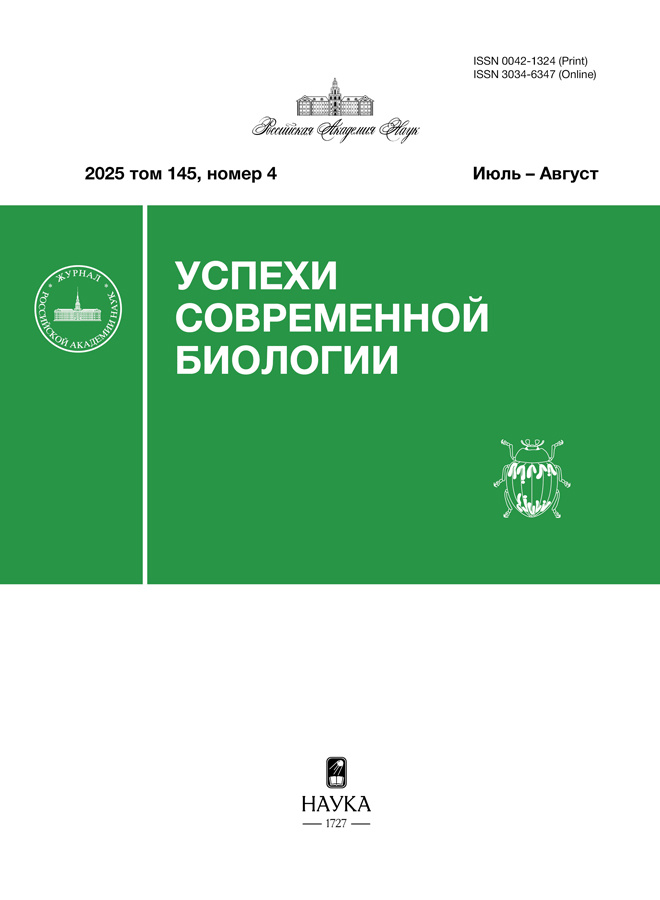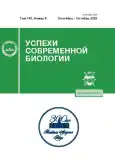Оценка морфологических аномалий и реакции гена hsp70 на воздействие аристолоховой кислоты у Neocaridina davidi (красная креветка)
- Авторы: Р П.1, Джитин Т.1
-
Учреждения:
- Кафедра биотехнологии, Колледж Мар Афанасия
- Выпуск: Том 143, № 5 (2023)
- Страницы: 506-511
- Раздел: Статьи
- Статья получена: 17.10.2023
- Статья опубликована: 01.09.2023
- URL: https://journals.rcsi.science/0042-1324/article/view/138976
- DOI: https://doi.org/10.31857/S0042132423040087
- EDN: https://elibrary.ru/DACSJN
- ID: 138976
Цитировать
Полный текст
Аннотация
Исследованы морфологические аномалии и сверхэкспрессия одного из генов стресса (hsp70) при различных концентрациях экстракта аристолохии Aristolochia. Растительный материал для исследования механически измельчен для приготовления настоя. Креветки Neocaridina davidi акклиматизированы в лаборатории. Воздействие аристолоховой кислоты на креветок в концентрациях 6000, 12 000, 18 000, 24 000 и 30 000 ppm через 48 ч приводит к морфологическим аномалиям развития начиная с концентрации 18 000 ppm. Анализ экспрессии показал, что транскрипция hsp70 у подвергнутых воздействию N. davidi при 24000 ppm (72 ч) выше, чем в контроле. Данные, полученные в ходе текущего исследования, помогают лучше понять токсичность аристолоховой кислоты, что указывает на необходимость регулирования производства и потребления растительных продуктов, содержащих аристолоховую кислоту в высокой концентрации.
Об авторах
П. Р
Кафедра биотехнологии, Колледж Мар Афанасия
Автор, ответственный за переписку.
Email: parvathyrbinu@gmail.com
Индия, Котамангалам, Керала
Т. Джитин
Кафедра биотехнологии, Колледж Мар Афанасия
Email: parvathyrbinu@gmail.com
Индия, Котамангалам, Керала
Список литературы
- Abhishiktha S.N., Saba S., Shrunga M.N. et al. Antimicrobial and radical scavenging efficacy of leaf and flower of Aristolochia indica Linn. // Sci. Technol. Arts Res. J. 2015. V. 4. P. 103–108. https://doi.org/10.4314/star.v4i1.17
- Al-Badran A.A., Fujiwara M., Mora M.A. Effects of insecticides, fipronil and imidacloprid, on the growth, survival, and behavior of brown shrimp Farfantepenaeus aztecus // PLoS One. 2019. V. 14. P. e0223641. https://doi.org/10.1371/journal.pone.0223641
- Bhattacharjee P., Bhattacharyya D. Characterization of the aqueous extract of the root of Aristolochia indica: evaluation of its traditional use as an antidote for snake bites // J. Ethnopharmacol. 2013. V. 145. P. 220–226. https://doi.org/10.1016/j.jep.2012.10.056
- Chen C.-H., Dickman K.G., Moriya M. et al. Aristolochic acid-associated urothelial cancer in Taiwan // PNAS USA. 2012. V. 109. P. 8241–8246. https://doi.org/10.1073/pnas.1119920109
- Das S., Mohapatra A., Sahoo P.K. Expression analysis of heat shock protein genes during Aeromonas hydrophila infection in rohu, Labeo rohita, with special reference to molecular characterization of Grp78 // Cell Stress Chaperones. 2015. V. 20. P. 73–84. https://doi.org/10.1007/s12192-014-0527-2
- Gökmen M.R., Cosyns J.-P., Arlt V.M. et al. The epidemiology, diagnosis, and management of aristolochic acid nephropathy: a narrative review // Ann. Inter. Med. 2013. V. 158. P. 469–477. https://doi.org/10.7326/0003-4819-158-6-201303190-00006
- Gupta S.C., Sharma A., Mishra M. et al. Heat shock proteins in toxicology: how close and how far? // Life Sci. 2010. V. 86. P. 377–384. https://doi.org/10.1016/j.lfs.2009.12.015
- Han J., Xian Z., Zhang Y. et al. Systematic overview of aristolochic acids: nephrotoxicity, carcinogenicity, and underlying mechanisms // Front. Pharmacol. 2019. V. 10. P. 648. https://doi.org/10.3389/fphar.2019.00648
- Hu X.L., Niu J.J., Meng Q. et al. Effects of two juvenile hormone analogue insecticides, fenoxycarb and methoprene, on Neocaridina davidi // Environ. Pollut. 2019. V. 253. P. 89–99. https://doi.org/10.1016/j.envpol.2019.06.120
- Jirovetz L., Buchbauer G., Puschmann C., Fleischhacker W. Analysis of the essential oil of the aerial parts of the medicinal plant Aristolochia indica Linn. (Aristolochiaceae) from South-India // Sci. Pharm. 2000. V. 68. P. 309–316. https://doi.org/10.3797/scipharm.aut-00-28
- Kanjilal P.B., Kotoky R., Couladis M. Chemical composition of the stem oil of Aristolochia indica L. // J. Essen. Oil Res. 2009. V. 21. P. 24–25. https://doi.org/10.1080/10412905.2009.9700098
- Lerma-Herrera M.A., Beiza-Granados L., Ochoa-Zarzosa A. et al. Biological activities of organic extracts of the genus Aristolochia: a review from 2005 to 2021 // Molecules. 2022. V. 27. P. 3937. https://doi.org/10.3390/molecules27123937
- Liang Z., Chen T., Yang F. et al. Toxicity of chronic waterborne zinc exposure in the hepatopancreas of white shrimp Litopenaeus vannamei // Chemosphere. 2022. V. 309. P. 136553. https://doi.org/10.1016/j.chemosphere.2022.136553
- Mahmood K., Jadoon S., Mahmood Q. et al. Synergistic effects of toxic elements on heat shock proteins // BioMed Res. Int. 2014. V. 2014. P. 564136. https://doi.org/10.1155/2014/564136
- Mei N., Arlt V.M., Phillips D.H. et al. DNA adduct formation and mutation induction by aristolochic acid in rat kidney and liver // Mutat. Res. 2006. V. 602. P. 83–91.
- Parolini M. Toxicity of the non-steroidal anti-inflammatory drugs (NSAIDs) acetylsalicylic acid, paracetamol, diclofenac, ibuprofen and naproxen towards freshwater invertebrates: a review // Sci. Total Environ. 2020. V. 740. P. 140043. https://doi.org/10.1016/j.scitotenv.2020.140043
- Rungrassamee W., Leelatanawit R., Jiravanichpaisal P. et al. Expression and distribution of three heat shock protein genes under heat shock stress and under exposure to Vibrio harveyi in Penaeus monodon // Dev. Comp. Immunol. 2010. V. 34. P. 1082–1089. https://doi.org/10.1016/j.dci.2010.05.012
- Shibutani S., Dong H., Suzuki N. et al. Selective toxicity of aristolochic acids I and II // Drug Metab. Dispos. 2007. V. 35. P. 1217–1222. https://doi.org/10.1124/dmd.107.014688
- Siregar P., Suryanto M.E., Chen K.H.-C. et al. Exploiting the freshwater shrimp Neocaridina denticulata as aquatic invertebrate model to evaluate nontargeted pesticide induced toxicity by investigating physiologic and biochemical parameters // Antioxidants. 2021. V. 10. P. 391. https://doi.org/10.3390/antiox10030391
- Soniya E.V., Sujitha M. An efficient in vitro propagation of Aristolochia indica // Biol. Plant. 2006. V. 50. P. 272–274.
- Tian Y., Niu J., Zhu Q. et al. Breeding of Tianfu broilers, Heilongjiang // Anim. Husb. Vet. Med. 2021. V. 6. P. 36–41.
- Venkateswara Rao J., Kavitha P., Jakka N.M. et al. Toxicity of organophosphates on morphology and locomotor behavior in brine shrimp, Artemia salina // Arch. Environ. Contam. Toxicol. 2007. V. 53. P. 227–232. https://doi.org/10.1007/s00244-006-0226-9
- Wang X., Giusti A., Ny A., Witte P.A. Nephrotoxic effects in zebrafish after prolonged exposure to aristolochic acid // Toxins. 2020. V. 12. P. 217. https://doi.org/10.3390/toxins12040217
- Xu D., Ran C., Yin L. et al. Acute and subchronic toxicity studies of aristolochic acid A in Tianfu broilers // Animals (Basel). 2021. V. 11 (6). P. 1556. https://doi.org/10.3390/ani11061556
- Yang L., Su T., Li X.-M. et al. Aristolochic acid nephropathy: variation in presentation and prognosis // Nephrol. Dial. Transplant. 2012. V. 27. P. 292–298.
Дополнительные файлы












